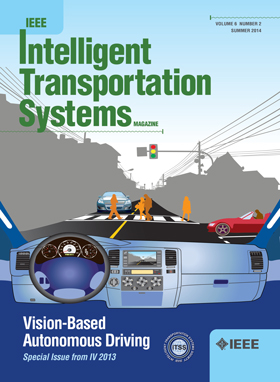Array Self-Position Determination Based on Orthogonal Grid Matching Under Multipath Environments
IF 7.9
1区 工程技术
Q1 ENGINEERING, CIVIL
IEEE Transactions on Intelligent Transportation Systems
Pub Date : 2025-02-18
DOI:10.1109/TITS.2025.3539634
引用次数: 0
Abstract
Array self-position determination methods based on multiple emitter data can avoid significant deviations of vehicle satellite navigation in harsh environments. However, existing array self-position determination methods show decrease in performance under multipath environments. To deal with this problem, we propose an array self-position determination method based on orthogonal grid matching with the spatial differencing method. Specifically, the direction of arrival (DOA) of direct path and multipath signals are respectively estimated by array spatial differencing method. The matching accuracy is enhanced by utilizing the prior information of direct path signal. After calculating correlation coefficients of different sources, estimated angles with high correlation are then classified into the same set. Then, the noise subspace of each angle set is reconstructed and the position is estimated by grid matching with the orthogonal property between the noise subspaces and the characteristic steering vectors. The matching results of redundant angle sets are removed as non-matching items, thus averting positioning deviations. The simulation results demonstrate that the computational complexity of the proposed method is comparable to that of the signal subspace fitting (SSF). Moreover, in terms of positioning precision, the proposed method outperforms multiple signal classification with enhanced spatial smoothing (ESSMUSIC), initial signal fitting (ISF), and SSF.多径环境下基于正交网格匹配的阵列自定位
基于多发射极数据的阵列自定位方法可以避免恶劣环境下车载卫星导航的显著偏差。然而,现有的阵列自定位方法在多径环境下的性能有所下降。针对这一问题,提出了一种基于正交网格匹配和空间差分法的阵列自定位方法。具体来说,利用阵列空间差分法分别估计了直接路径信号和多路径信号的到达方向DOA。利用直路信号的先验信息,提高了匹配精度。在计算不同源的相关系数后,将高度相关的估计角度分类到同一集合中。然后,重构每个角度集合的噪声子空间,利用噪声子空间与特征转向向量之间的正交特性进行网格匹配,估计出每个角度集合的位置;冗余角度集的匹配结果被剔除为不匹配项,避免了定位偏差。仿真结果表明,该方法的计算复杂度与信号子空间拟合(SSF)相当。此外,在定位精度方面,该方法优于多信号分类增强空间平滑(ESSMUSIC)、初始信号拟合(ISF)和SSF。
本文章由计算机程序翻译,如有差异,请以英文原文为准。
求助全文
约1分钟内获得全文
求助全文
来源期刊

IEEE Transactions on Intelligent Transportation Systems
工程技术-工程:电子与电气
CiteScore
14.80
自引率
12.90%
发文量
1872
审稿时长
7.5 months
期刊介绍:
The theoretical, experimental and operational aspects of electrical and electronics engineering and information technologies as applied to Intelligent Transportation Systems (ITS). Intelligent Transportation Systems are defined as those systems utilizing synergistic technologies and systems engineering concepts to develop and improve transportation systems of all kinds. The scope of this interdisciplinary activity includes the promotion, consolidation and coordination of ITS technical activities among IEEE entities, and providing a focus for cooperative activities, both internally and externally.
 求助内容:
求助内容: 应助结果提醒方式:
应助结果提醒方式:


